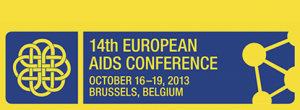Approaches to once-daily raltegravir: new formulation likely to require food
1 December 2013. Related: Conference reports, Antiretrovirals, EACS 14 Brussels 2013.
 Simon Collins, HIV i-Base
Simon Collins, HIV i-Base
Several raltegravir pharmacokinetic studies were presented at EACS 2013 looking at whether there is potential for once-daily dosing.
New once-daily formulation
Results from a PK study involving a new once-daily formulation of raltegravir were presented as a poster. [1]
However, the new formulation required a higher daily milligram dose, compared to the current formulation.
This was an open-label, single-dose, randomised, 2-cohort, 3-period, crossover, study looking at the impact of food, in 36 HIV negative volunteers. The once daily formulation using 2 x 600 mg tablets was compared to 3 x 400 mg tablets using the current formulation. This is a 50% higher daily dose than currently used.
Interpreting the results from this study is therefore problematic, given that the current formulation is licensed at a dose of 1 x 400 mg tablet twice-daily (to be take with or without food) and this was not included as a control arm.
PK results and geometric mean (CV%) are reported in Table 1.
In summary, the new reformulation reported a divergent relationship with food depending on whether this was a low fat meal. There were decreases in all parameters when coadministered with a low fat meal and increases in AUC and Cmax (and similar C24hr) with a high fat meal.
The current formulation similarly reported reductions in all PK parameters with a low fat meal which with a high fat meal attenuated the reductions in AUC and Cmax and increased C24hr.
| AUC (%CV) | Cmax (%CV) | C24hr (%CV) | |
|---|---|---|---|
| Reformulated, fasted, multiple dose | 34.9 µM-hr (122%) | 9.4 µM (203%) | 46.3 nM (54%) |
| Standard, fasted, multiple dose | 58.1 µM-hr (67%) | 23.1 µM (77%) | 59.8 nM (87%) |
| Reformulated + low fat meal, single dose | 40% decrease | 52% decrease | 16% decrease |
| Reformulated + high fat meal, single dose | 3% increase | 28% increase | 12% decrease |
| Standard + low fat meal, single dose | 71% decrease | 75% decrease | 18% decrease |
| Standard + high fat meal, single dose | 26% increase | 24% decrease | 70% increase |
A second raltegravir PK study (with a strange design) compared pharmacokinetic parameters of two doses of 400 mg raltegravir, taken 12 hours about, to a single 800 mg dose which was chewed rather than swallowed.
The missing comparators, given that that is comparing a new method of administration, of either a 400 mg BID chewed group, or an 800 mg QD swallowed group make the higher peak concentrations reported with the QD dose impossible to interpret, as is the reported reduction in interpatient variability for AUC.
The current indication for raltegravir is to swallow tablets and not to chew them.
A third study reported results from using the twice-daily formulation with once-daily dosing in treatment experienced patients who were had been virally suppressed to <50 copies/mL for at least 6 months. This was a single-arm observational study in 71 patients (17/71 were already using raltegravir twice-daily for a median of 8 (range 1–28) months.
Median duration of previous treatment was 14 years (range 1–22) years with a median five previous combinations (range 1–15). Median CD4 count was 588 cells/mm3 (range 248–1328).
The backbone combinations used with the once-daily switch were: tenofovir/FTC (n=40), abacavir/3TC (n=13), etravirine (n=7), atazanavir (n=7), nevirapine (n=3) and efavirenz (n=1).
The percentage of patients who remained undetectable at week 24 (the primary endpoint) was 99 % (95%CI: 96-100%) and 96% (95%CI: 91–100 %) at week 96. One patient had virological failure by week 24 with two further cases by week 48.
Resistance to raltegravir was detected at virological failure in 2/3 patients and was also associated with previous resistance drugs used in the backbone combination.
Comment
Although raltegravir has impressive virological and safety results, and is included as a preferred option for first-line ART in treatment guidelines, this is a twice-daily drug.
In earlier studies, notably in the QDMRK, once daily raltegravir failed to show non-inferiority to twice-daily dosing in treatment naïve patients with rates of 83% vs 89% virological response (difference -5·7%, 95% CI -10·7 to -0·83; p=0·044). [4]
The new formulation reported by Krishna et al requires a higher daily dose than the current dose (1200 mg vs 800 mg daily) and may require to taking with a high fat meal. Although the C24hr levels seem okay, overall bioavailability seems less and it is unclear whether this is compensated for by reduced interpatient variability.
The study by Cattaneo et al by chewing chalky tablets s impossible to interpret.
Finally, the study by Caby et al, although small and without a control group, suggests that QD dosing by doubling the current dose may be a switch option when background drugs are fully active and there is no historical likelihood of drug resistance. Similar results has been reported in other small studies and suggests that switching to QD once suppressed might have been a better study design for the QDMRK study.
References:
Unless stated otherwise, references are to the 14th European AIDS Conference. October 16-19, 2013. Brussels.
- Krishna R et al. A single dose food effect study of raltegravir (RAL) formulations. 14th EACS, 2013. Poster abstract PE10/17.
http://www.eacsmobile.org/libraryEntry/show/526255914546019879 - Cattaneo D et al. Comparison of the pharmacokinetics of raltegravir given at 400 mg BID by swallowing versus 800 mg QD by chewing in healthy volunteers: a randomized, open-label, two-period cross-over phase 1 study. 14th EACS, 2013. Poster abstract PE 7/10.
http://www.eacsmobile.org/libraryEntry/show/1008804876468059748 - Caby F et al. Efficacy of raltegravir once daily in switching strategies in HIV-1 infected patients with suppressed viraemia. 14th EACS, 2013. Abstract BPD 1/7.
http://www.eacsmobile.org/libraryEntry/show/526255914546019879 - Eron J et al. Raltegravir once daily or twice daily in previously untreated patients with HIV-1: a randomised, active-controlled, phase 3 non-inferiority trial (QDMRK). Lancet Infect Dis. 2011;(12):907-915.

